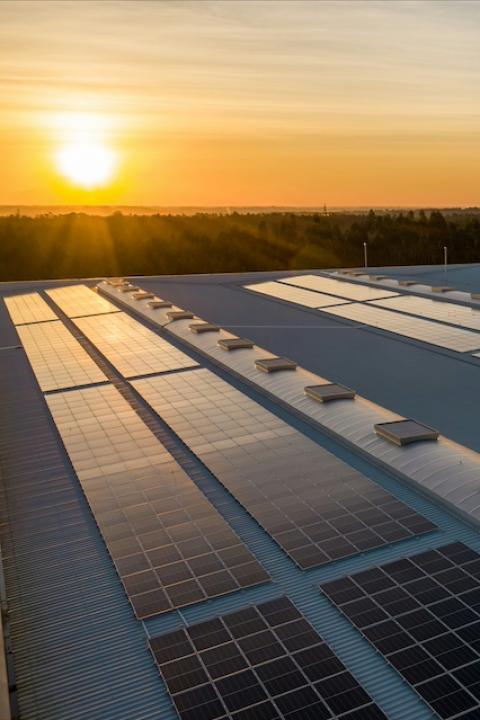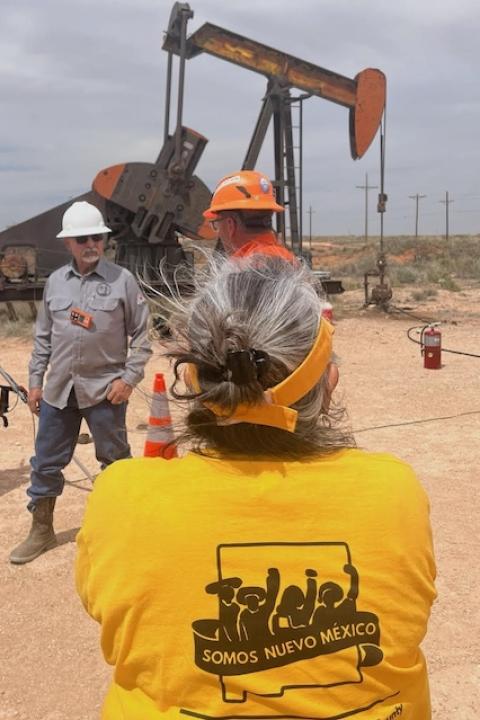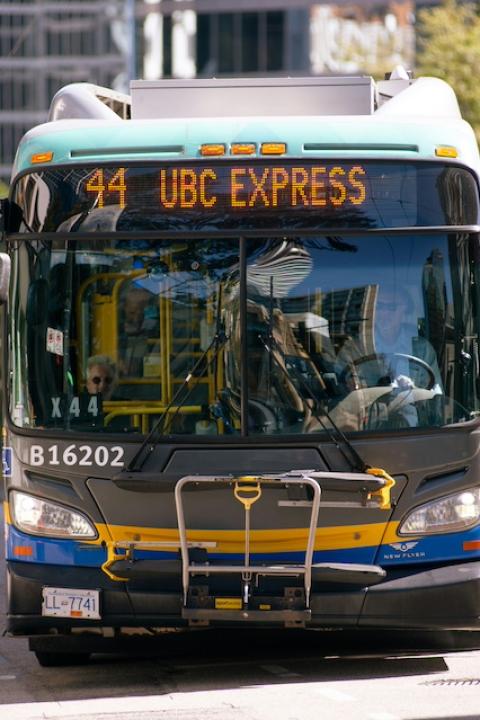
Clean Energy Resource Teams, a statewide program in Minnesota, hosts a tour of the community solar gardens at Lake Region Electric Cooperative, a member-owned electricity cooperative providing power to around 26,000 residents. (Image: CERT/Flickr)
Rooftop solar panels and energy storage can unlock economic benefits for households, but until recently the main beneficiaries were in the higher income brackets. A movement is underway to open up these benefits to low- and middle-income households through community-based solar projects. In recent years, nonprofit organizations and government programs have pushed community solar from a fringe concept into a mainstream movement, and businesses can participate as well.
Community solar goes mainstream
Households with solar panels and energy storage can sell excess electricity back to the grid, take advantage of discounted rates, and keep the lights on during emergencies. However, many households are excluded from these benefits because they don’t have access to their own roof, lack financial support or both.
Community solar projects are one way to help households without roof access. They were all but unknown in the U.S. until 2006 when the city of Ellensburg, Washington, launched the first known community solar project in the nation. Rather than having individual ratepayers install their own rooftop solar panels, the Ellensburg project enables ratepayers to subscribe to a nearby solar array.
In the early years, community solar projects served a relatively limited purpose. Solar power was expensive, and subscribers typically paid a premium because they wanted to do something for the environment, not necessarily to save money.
Community solar projects were also typically small. The Ellensburg project, for example, was expanded several times after 2006, but its capacity is still listed at just 304 kilowatts.
Still, small renewable energy projects can have a collectively big impact on the nation’s overall energy profile. The U.S Department of Energy has been planning for a modernized grid that incorporates more distributed energy resources, like rooftop solar and community solar, and is less reliant on large, centralized power plants.
Due to Energy Department support and the plummeting cost of solar power, community solar projects have gotten much bigger since 2006, and they are also more holistic in terms of goals.
One recent example is the new Green Energy Justice Cooperative, an initiative launched by the Illinois energy equity organization Blacks in Green.
Earlier this month, the Cooperative won a contract to develop 9 megawatts of solar power spread among three new community solar projects. The contract represents “one of the nation’s largest non-utility-based solar projects launched by a clean energy co-op,” according to Blacks in Green. It will benefit low- and middle-income households in Aurora, Naperville, Romeoville, and surrounding Illinois communities with lower electricity rates.
The project is supported by a network of nonprofits, many of which have a decades-long footprint in local workforce and economic development. The Minnesota nonprofit Cooperative Energy Futures, a member-owned clean energy cooperative, is also a supporter.
In addition to saving money, Blacks in Green emphasizes the holistic benefits of community solar. They list “co-ownership of the solar co-op and accompanying profit sharing; a voice in the management of the clean energy cooperative; equitable workforce training and capacity development; and the opportunity to help create an equitable clean energy transition that provides meaningful benefits to people and protects the environment.”
A community solar model for businesses to follow
Businesses are also moving to act in support of large-scale community solar initiatives. Last week Tapestry, the parent company of Coach, Kate Spade and Stuart Weitzman, announced a new community solar partnership with the certified B Corporation Pivot Energy to develop six solar projects in Illinois over the next two years for a total of 33 megawatts.
As with the Blacks in Green project, the new community solar projects are expected to reduce electricity costs for ratepayers in the area.
Tapestry and Pivot also anticipate that the project will provide a model for other businesses to follow. In support of the project, Tapestry will buy the equivalent of 750,000 megawatt-hours of renewable energy credits (RECs) over the next 15 years. Pivot describes these as “impact” RECs aimed at helping underserved communities replace fossil resources with solar power. Businesses participating in the impact REC model also contribute directly to community programs, particularly in the area of workforce development.
“What makes this project unique is the multifaceted opportunity to create measurable impact growth of solar energy,” a press announcement from Pivot Energy reads. “Traditional REC purchases typically come from existing wind farms, while Impact REC agreements are structured to put clean energy resources in areas primed to build new solar resources while simultaneously investing in local communities.”
For Pivot and Tapestry, "the impact is three-fold — new clean energy, community investments, and energy burden relief,” the announcement reads.
The power of partnerships
The new partnership helps to fulfill Tapestry’s goal of powering its operations with 100 percent renewable energy by 2025 while also contributing more broadly to community development.
“At Tapestry, we know that sustainability is a business imperative … We also recognize the power of partnerships to drive meaningful change in key environmental and social areas,” said said Logan Duran, Tapestry’s vice president for ESG and sustainability.
Businesses seeking to participate in community solar projects can also learn from the cooperative model deployed by GEJC and Cooperative Energy Futures. These new organizations have much in common with the federal Rural Electric Cooperative initiative launched during the Great Depression. The initiative aimed to electrify rural communities overlooked by for-profit utility companies. Today these ratepayer-owned cooperatives continue to serve 21.5 million businesses, homes, schools and farms across 48 U.S. states, including those in urban and suburban areas.
Electric cooperatives have also become powerful drivers of the clean energy transition. That includes supporting community solar projects, which the National Rural Electric Cooperative Association is promoting through its Achieving Cooperative Community Equitable Solar Sources resource program.
Charitable giving can also provide business leaders with opportunities to support community solar projects. The nonprofit solar provider RE-volv, for example, recently received a $3 million donation from the Kresge Foundation and the Schmidt Family Foundation in support of its pay-it-forward model for financing community solar and rooftop solar projects.
Businesses seeking to support community solar programs may also find new opportunities to coordinate with state and federal efforts. Last year, for example, the Joe Biden administration issued new guidance that supports community solar programs accessible by residents of housing assisted with funds from the Department of Housing and Urban Development.
The Department of Energy is stirring additional movement through its administration of the National Community Solar Partnership, which is working toward a goal of providing the equivalent of 5 million households with solar power by 2025.
“This target represents a 700 percent increase in community solar deployment, growing from 3 GW [gigawatts] of community solar in 2020 to 20 GW in 2025,” according to the Energy Department.
The Inflation Reduction Act is also stimulating more activity. Much attention has been paid to the large commercial renewable energy projects stimulated by the legislation, but money has also been pouring into programs that support rooftop and community solar projects.
In June, for example, the Environmental Protection Agency launched a new $7 billion fund through the Inflation Reduction Act. Called the Solar for All competition, the new fund will support innovative new projects that expand access to rooftop and community solar for households in low-income and disadvantaged communities.
Businesses seeking to ensure that the outcome of the COP28 climate talks leads to meaningful action can start in their own backyards by supporting the community solar movement.

Tina writes frequently for TriplePundit and other websites, with a focus on military, government and corporate sustainability, clean tech research and emerging energy technologies. She is a former Deputy Director of Public Affairs of the New York City Department of Environmental Protection, and author of books and articles on recycling and other conservation themes.














